24 Jan A piece of Denmark by the Ganges
Visit Serampore to discover its quaint and unique blend of Danish and local monuments
The mention of Denmark brings to mind images of forests and reindeers and the fairytale stories of Hans Christian Andersen. But the Danes were also known as fierce explorers with a naval dominance that spawned them a trading empire stretching all the way to Bengal.
Denmark were the masters of Serampore for close to a century. And the town hosts a wealth of hidden gems to show for it, showcasing the cultural fusion of old Bengal and Europe. Now, thanks to the West Bengal government and the National Museum of Denmark, the old buildings and cultural heritage that was neglected over the years has been restored for us to explore and enjoy.
Churches, Cemeteries, Rajbaris, Pagodas…a short drive from Kolkata
I visited Serampore with the soft-spoken Mohit Ranadip of the Serampore Heritage Restoration Initiative, which has been documenting the town’s history and restoring its Danish-era buildings. We drove from Kolkata; over the soaring Vidyasagar Setu with the vast Hooghly below us, past verdant countryside speckled with still-water pukurs and bustling roadside commerce, reaching Serampore in an hour-and-half.
We stopped first at St Olav’s Church in the historic heart of town. During the Danish era, this was the hub for all social and religious events for Europeans living here (the town at the time was named Frederiksnagore by the Danes).
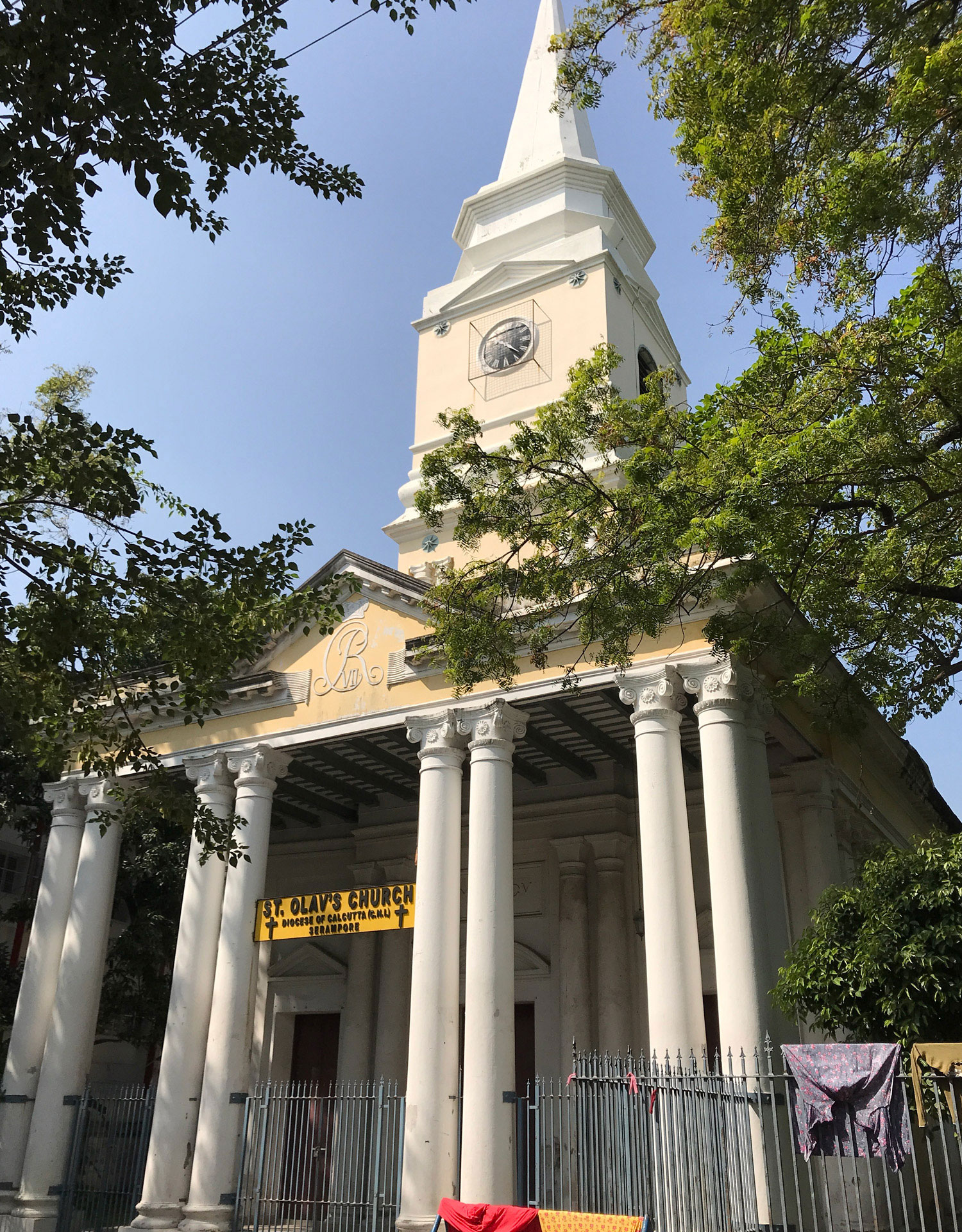 St Olav’s Church is famous for its white spire and the still-visible royal monogram of the King of Denmark
St Olav’s Church is famous for its white spire and the still-visible royal monogram of the King of Denmark
The church was locked, and despite much rattling of the doors there was no caretaker in sight. We walked around the pretty building, with the royal monogram of the King of Denmark, Christian VII, still adorning its entrance. The church’s gleaming white spire soared above us, famous for being visible from as far away as Barrackpore on the opposite shore of the Hooghly.
St Olav’s tapering white steeple was a favorite subject for Lady Canning to feature in her paintings whenever she visited Barrackpore in the 1850s. Charlotte Canning, the nature loving wife of Viceroy Lord Canning, is buried at the spot where spent hours painting these scenes. Lady Canning’s grave by the Barrackpore river front– overlooked by an equestrian statue of her husband – is today one of Barrackpore’s leading, if somewhat poignant, visitor attractions.
When St Olav’s was built in 1806, there were very few Danish people living in Serampore. So the church never had a Danish pastor and the services were led instead by a famous trio of English missionaries; about whom we will learn more later.
The Danish Government House; the seat of power and home of Ole Bie
Adjoining St Olav’s is the Government House, also restored to its original colors of bright yellow and white with massive green window shutters. It was from this building that power flowed; as the seat of administration and also the home of Ole Bie who built this Danish colony.
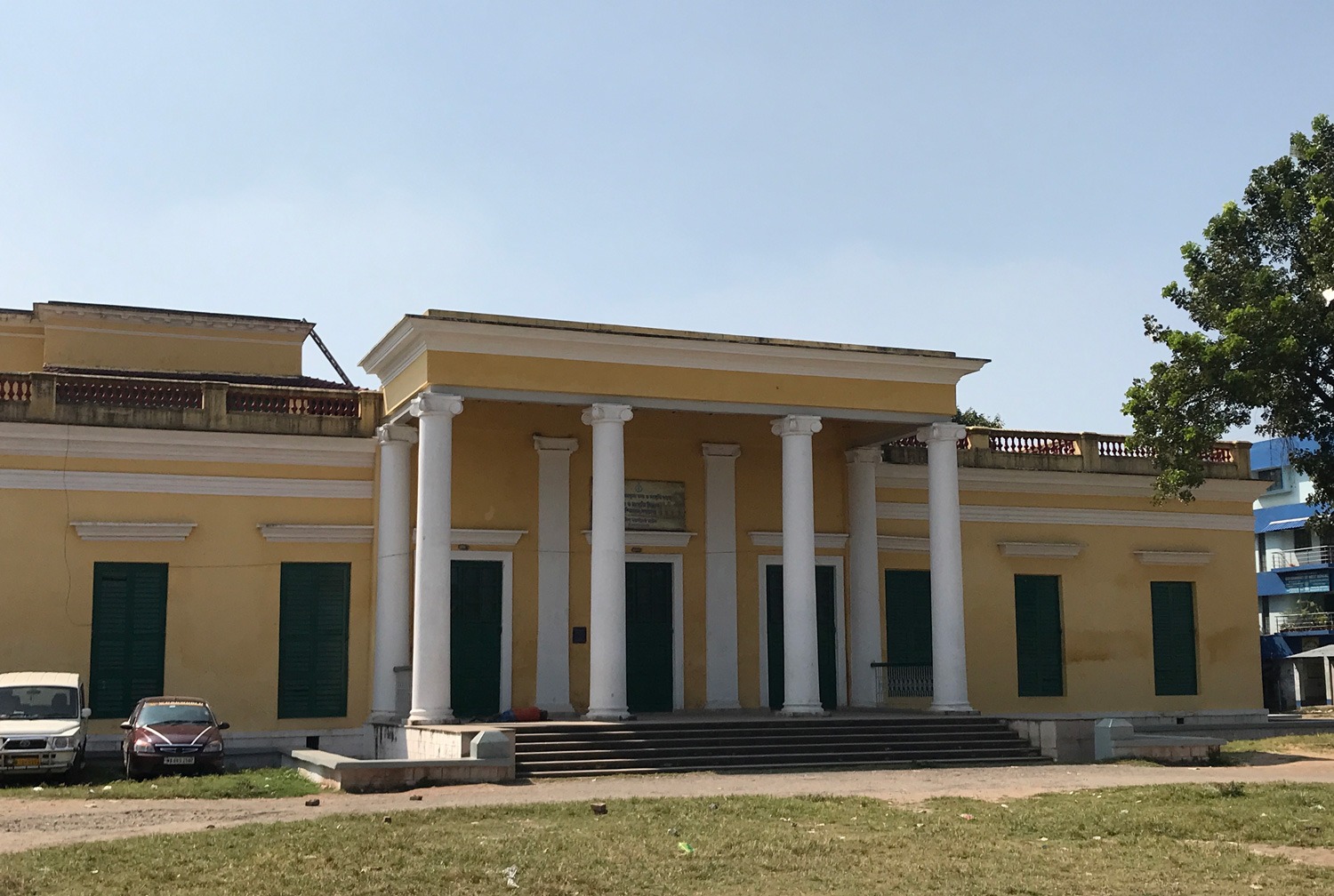 The restored Danish Government House was the seat of administration through colonial times and even after Independence
The restored Danish Government House was the seat of administration through colonial times and even after Independence
Ole Bie was born in Norway in 1733 and arrived in India in his mid-twenties, spending 30 eventful years at Seramapore and developing it as a vibrant multi-cultural town. Unfortunately, things did not end well for him. In his later years, Bie was accused of corruption and died bankrupt in 1805 at the age of 72. He is buried locally in the Danish cemetery where his grave is still a top draw.
How did the Danes arrive at this slice of the Hooghly? it was Bengal’s Mughal Governor Nawab Alivardi Khan who allowed the Danish Asiatic Company to settle on a small plot of land along the river at Serampore. They were given the rights to trade in exchange for payment of customs duties. The Danes started with a small warehouse surrounded by a mud wall, but soon they gained the right to collect taxes and exercise law in the area and their business boomed. By 1832, a census recorded 9219 Hindus, 2216 Muslims and 488 Christians living in Serampore of whom around 200 were Danes and the rest mainly French or British.
It is said that in its heyday the Danish East India Company imported more tea than its famous English counterpart. And given that Denmark’s population at the time was less than a million, promptly smuggled most of that valuable tea to Britain at great profit…
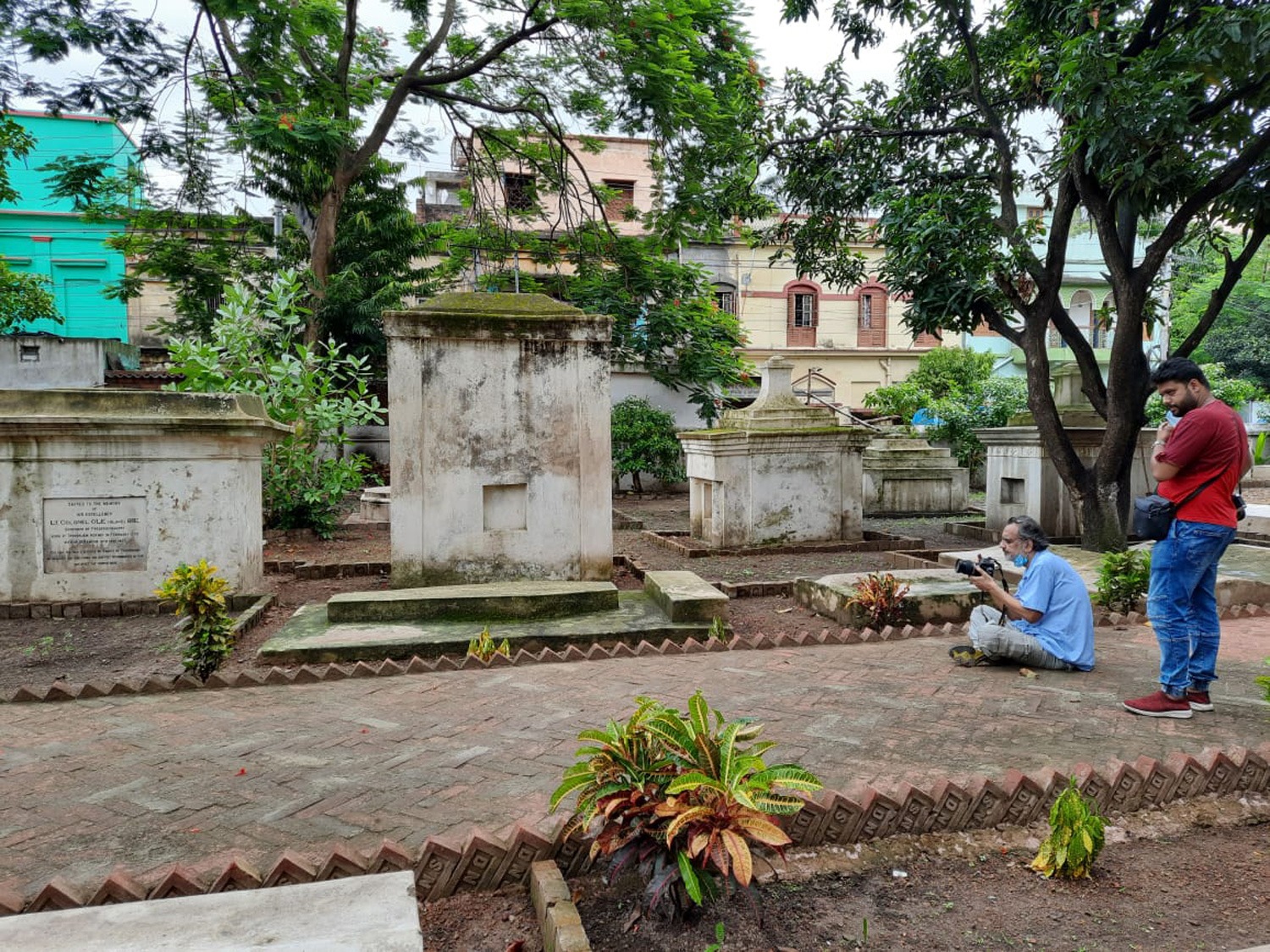 The grave of Ole Bie is a big draw in the Danish cemetery at Serampore
The grave of Ole Bie is a big draw in the Danish cemetery at SeramporeThe missionaries of Serampore : William Carey and the “Serampore Trio”
When the East India Company first set up in India, its Directors banned missionary activity for fear of it agitating the locals and interfering with its commerce. As the missionaries arriving in India were generally unwelcome in the English-ruled territories, several found refuge in Danish-controlled Serampore instead.
William Carey, an English Baptist priest, was the first of them. He founded the Serampore Mission in 1800 and was joined by two others – Joshua Marshman and William Ward. Together the “Serampore Trio” established India’s first printing press for translating the Gospel to local languages and founded the massive Serampore College.
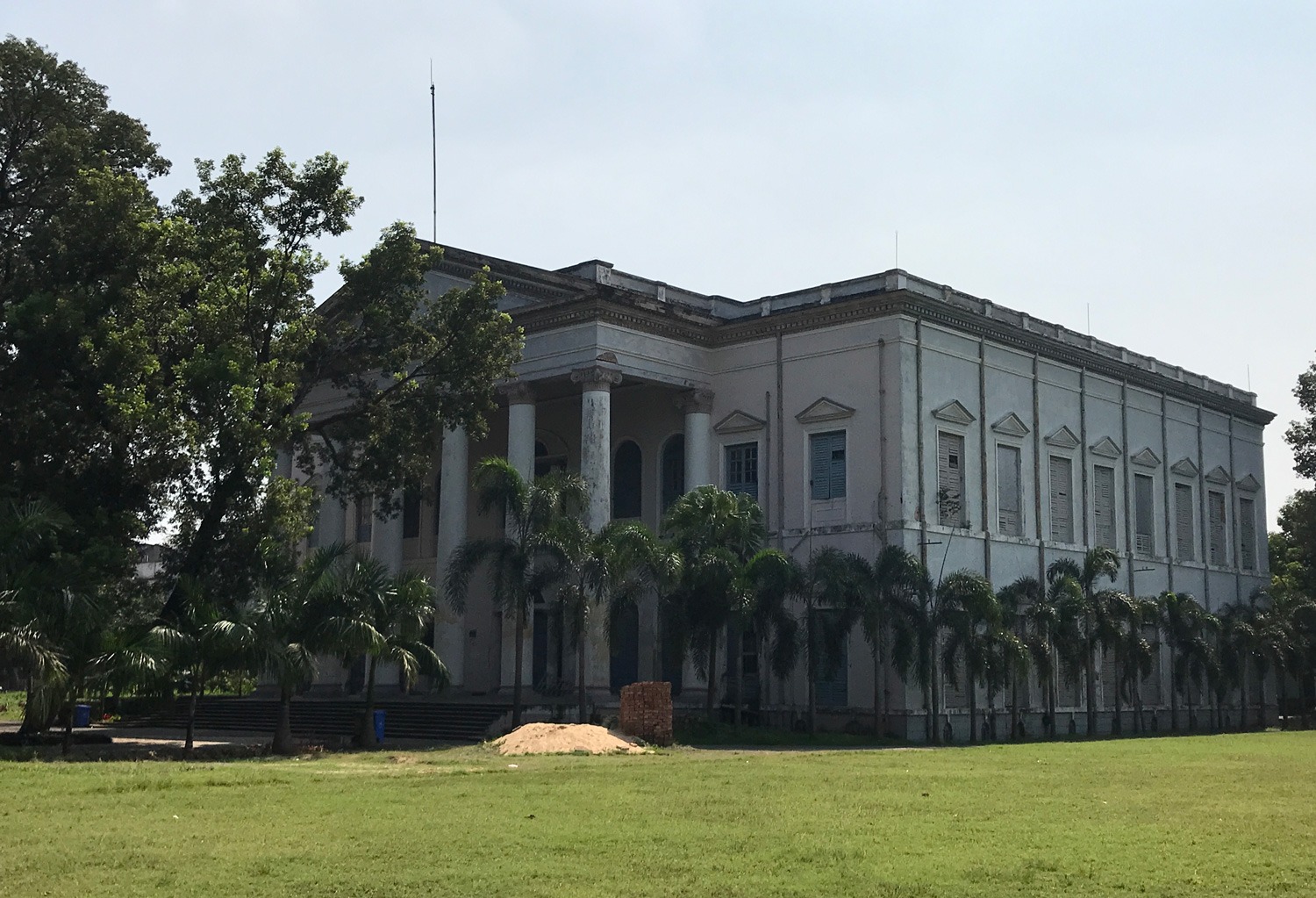 A Danish University in India; William Carey started the Serampore College as India’s third oldest college. It is still a top institution for Theology
A Danish University in India; William Carey started the Serampore College as India’s third oldest college. It is still a top institution for Theology
We entered the quiet, leafy campus of Serampore College that was dominated by a huge central building with towering ionic pillars, now declared a heritage structure. The college was built in 1818 as the third oldest college in the country and was granted a royal charter by the King of Denmark to confer degrees. It remains one of India’s major centers for studying Christian theology.
The college grounds were dotted with reminders of Carey and his fellow missionaries; the home that Carey stayed in, a museum, busts of the trio. I was curious to meet with future priests studying here and walked towards the students’ hostel – an open quad ringed by rooms and winding wrought-iron staircases. Music and happy laughter filled the air as I chatted with young men and women from all over the country studying for a 4-year Bachelor of Divinity course.
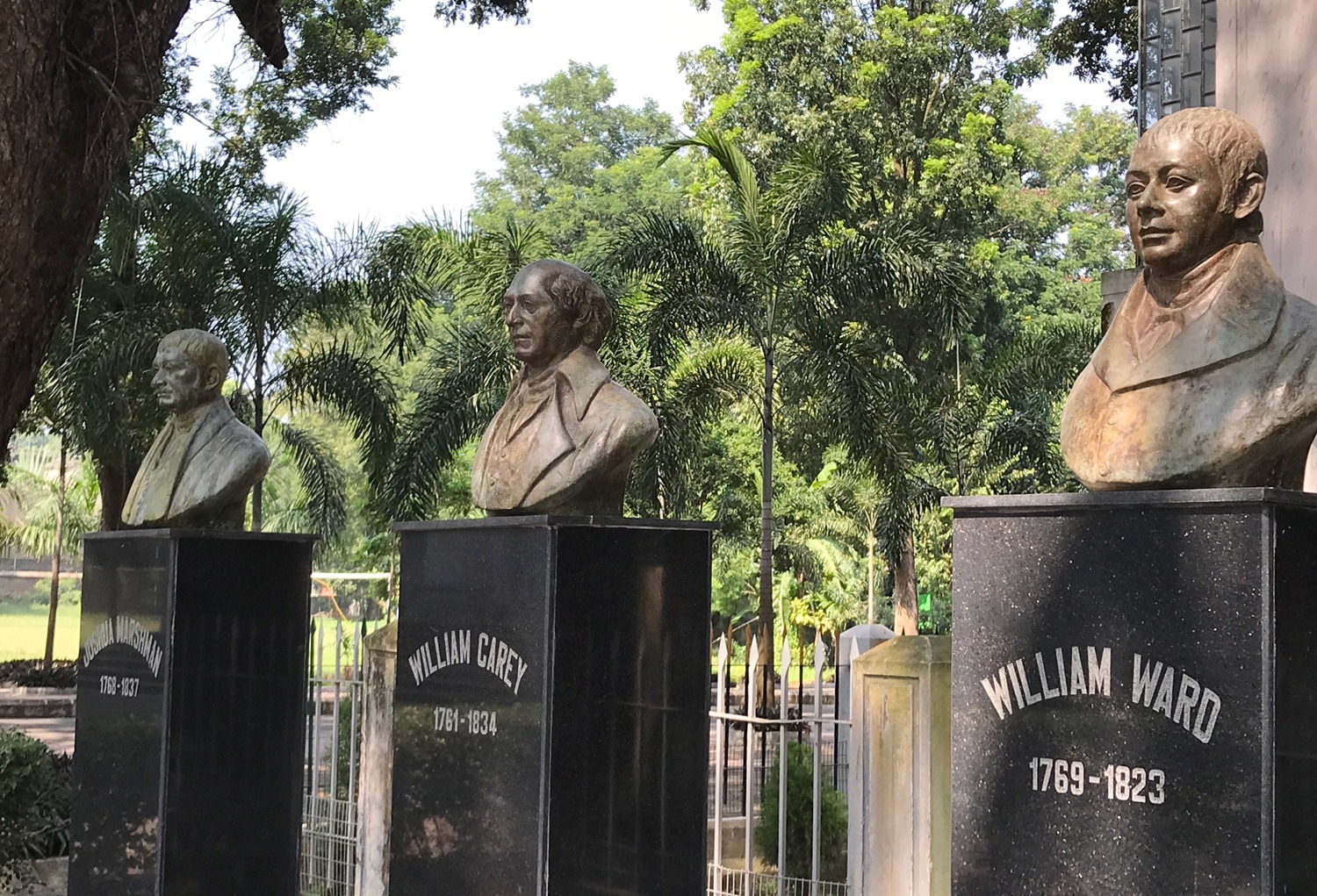 The Serampore trio of mighty missionaries: William Carey, Marshman and Ward
The Serampore trio of mighty missionaries: William Carey, Marshman and WardThe story of Henry Martyn and his charming pagoda
The missionaries have left us other legacies in Serampore; hidden gems filled with atmosphere and magic which are must-visits. One is the charismatic riverfront pagoda of Henry Martyn and the other is the Mission Cemetery where the trio are buried and laid to rest.
Henry Martyn was a Cambridge-educated priest who arrived in Calcutta as an East India Company chaplain. He spent several years travelling India before going to Iran where he died at the still young age of 31. An introverted, intense character Martyn was taken under his wing by Carey and lived in Serampore for a few months; in an old abandoned temple which has ever since been called “Henry Martyn’s Pagoda”.
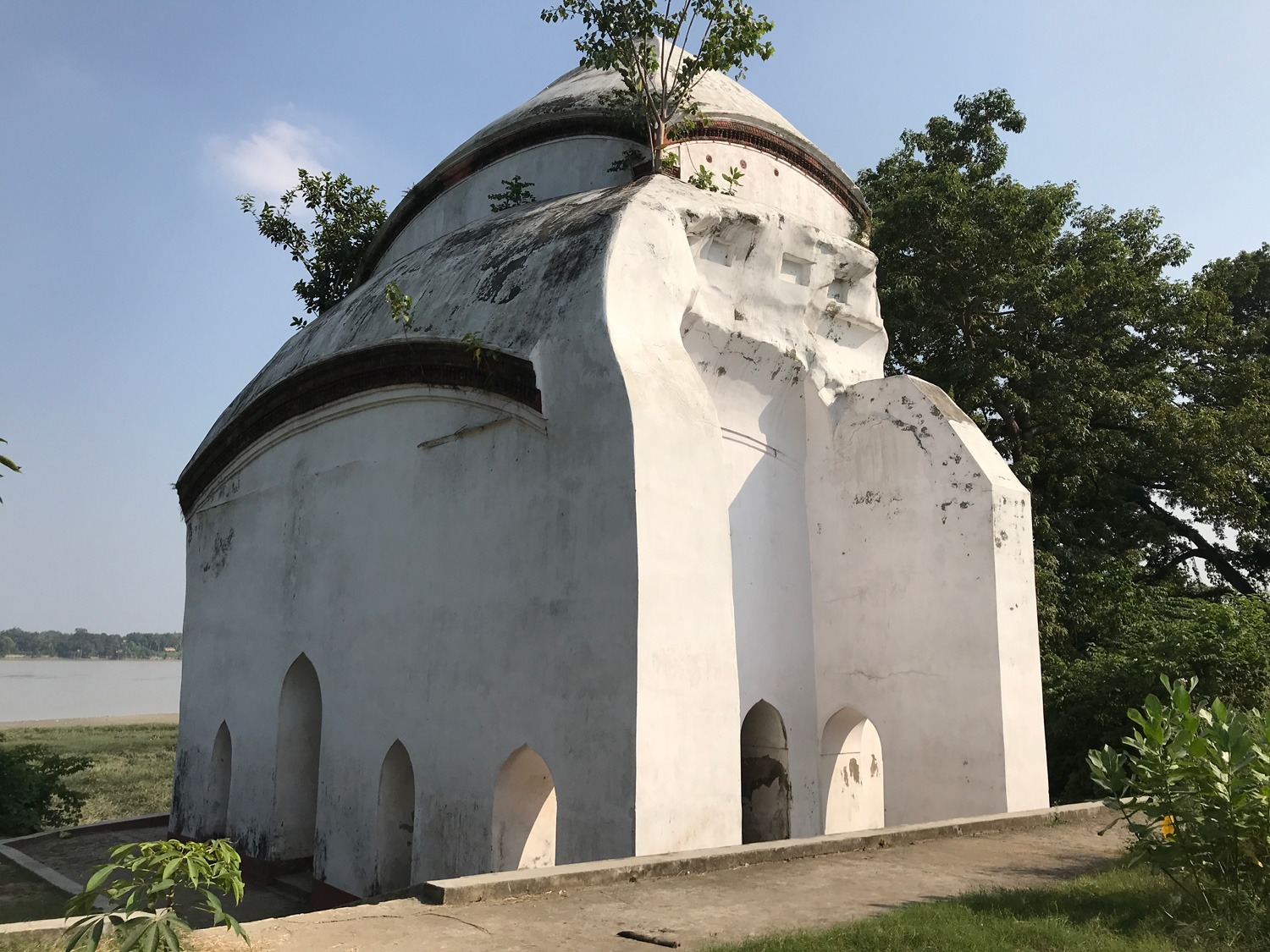 The atmospheric Henry Martyn’s pagoda is a memorial to his adventures in India
The atmospheric Henry Martyn’s pagoda is a memorial to his adventures in India
To get to Martyn’s pagoda, Mohit and I trekked along a kucha path filled with overgrown shrubs, their prickly leaves brushing my sleeves as we walked one behind the other. After passing the silent, brooding water tanks of the now-defunct Howrah Water Works, we came to a pagoda-like building standing remote along the edge of the river.
In his journals, Henry Martyn described his first day here in May 1806; “…the habitation assigned to me is a pagoda…on the edge of the river. Thither I retired at night…I prayed out loud to my God, and the echoes returned from the vaulted roof…I like my dwelling much; it is so retired and free from noise; it has so many recesses and cells, that I can hardly find my way in and out”.*
I stood inside the pagoda and could feel the heaviness of the air wafting off the Hooghly’s surface. The river seemed still, with only the swirling eddies on its surface and a few slow-moving boats indicating any movement. This is where Martyn lived and prayed and engaged in passionate, moonlit debates. The idea of western civilization sailing across the seas and hacking through jungles to have these moments of encounter with alien cultures has probably played itself out for hundreds of years. Here I was, standing on one such site.
And what of Carey himself? The missionary-trio lie buried at the Mission Cemetery, a small patch of calm in the middle of Serampore’s residential colonies. As we had prior permission to visit, a guard opened its iron gates for us. Unfortunately, the graveyard was not well maintained. We waded through knee-deep grass to find the graves William Carey, his wife Dorothy (who died unfortunately of a mental breakdown) and son Felix all resting together side by side. And further within the burial ground were the more substantial structures that housed the remains of William Ward and Joshua Marshman. All three missionary friends and colleagues now rest together in Serampore, a place they had called home for much of their lives.
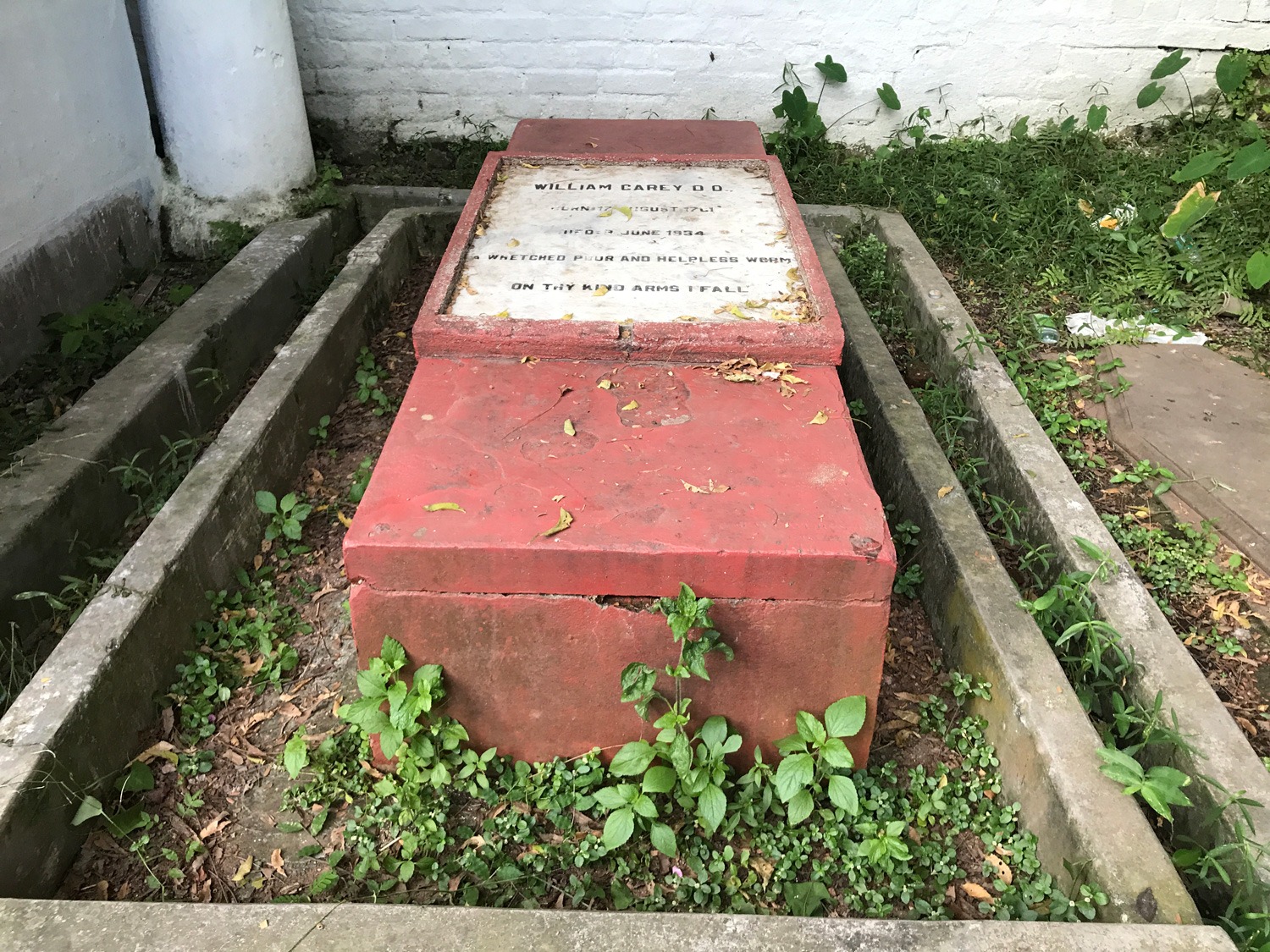 The final resting place of William Carey; the end of a life of passion and struggle
The final resting place of William Carey; the end of a life of passion and struggle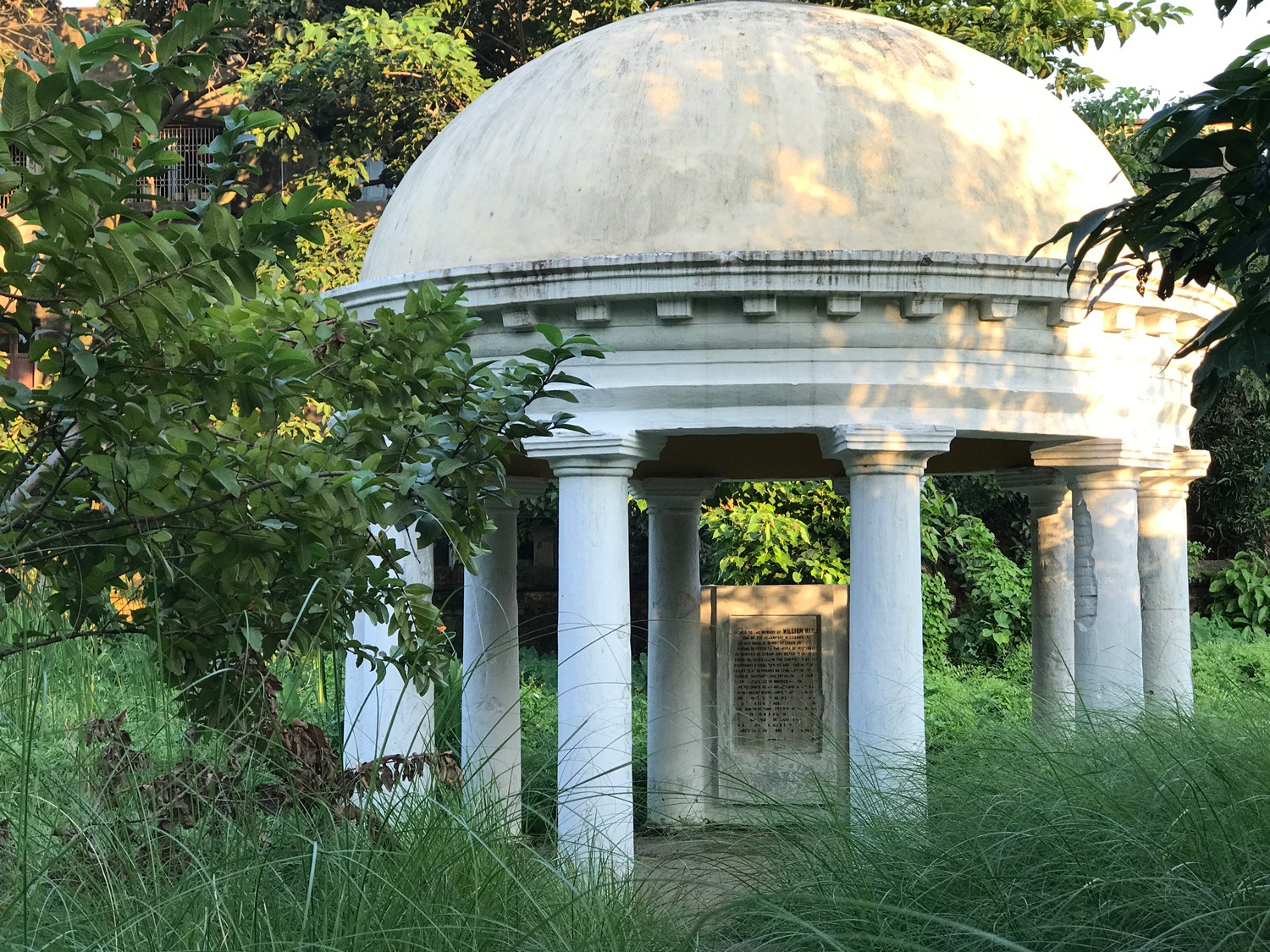 The cupola-like grave of William Ward survives in the undergrowth
The cupola-like grave of William Ward survives in the undergrowth Goswami Rajbari and a peek at the wealth of Bengali merchants
Serampore’s multi layered story had another angle to it; Bengali merchants who made their fortunes trading with the Europeans. There was none bigger than the Goswami family, who were rumored to be so wealthy that they bid to buy Serampore in 1845 when the Danes decided to abandon the colony and sell-out to the British.
Raghuram Goswami constructed the palatial Goswami Rajbari around 1800, in a mix of European and Indian architecture styles. It has over 100 rooms and is clearly Serampore’s largest palace. As I passed under the Rajbari’s massive double-arches I entered a courtyard with fluted columns and soaring pillars at least 30 feet in height. A higher floor with a running balcony and stained-glass windows ringed the courtyard. I could easily picture the family’s wealth and influence and imagine this mansion hosting lavish parties of food and drink. I wished I could have met members of the family to understand the enormity of maintaining such a massive legacy.
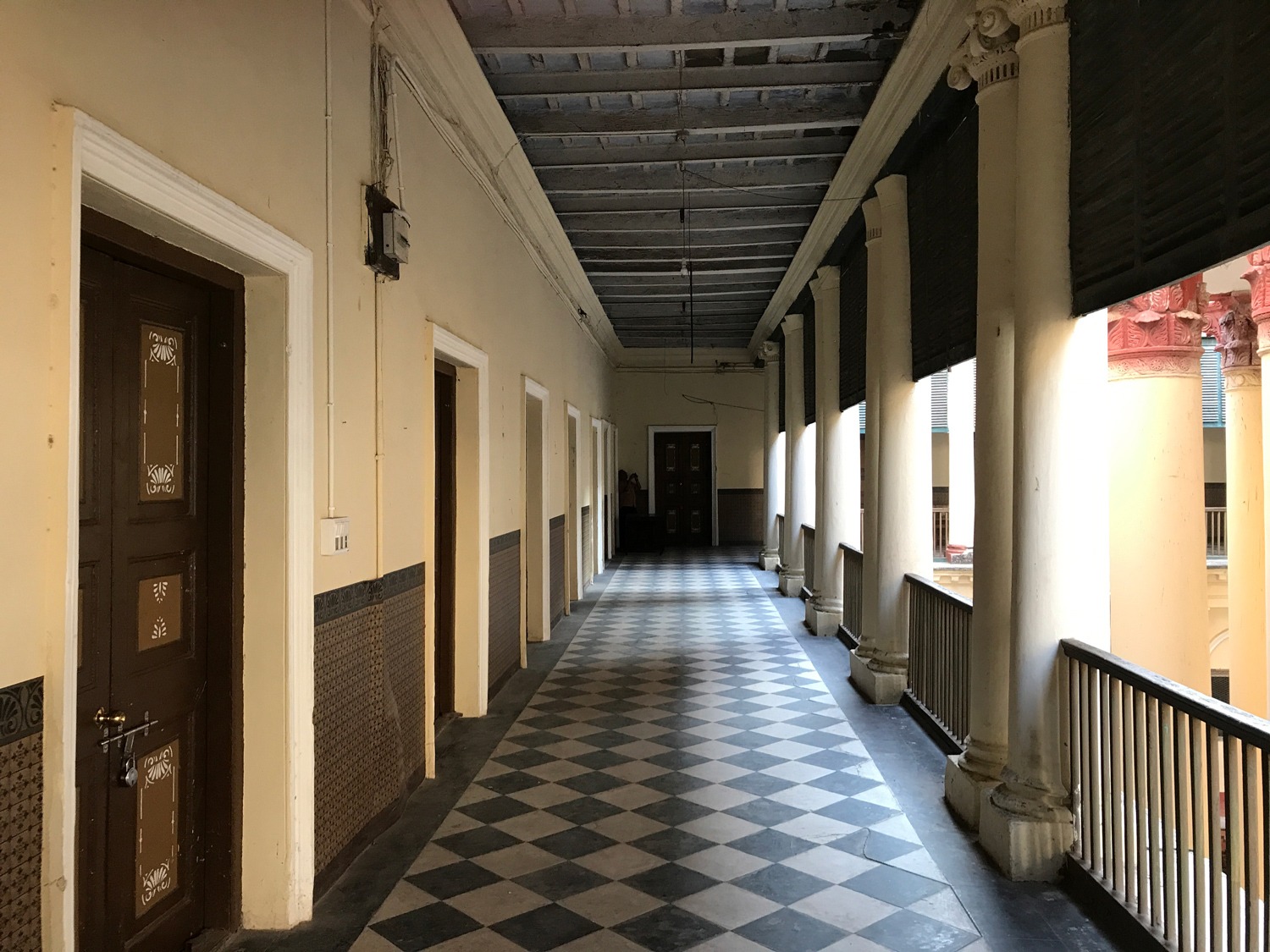 The checkered floors and silent locked rooms of Goswami Rajbari
The checkered floors and silent locked rooms of Goswami Rajbari 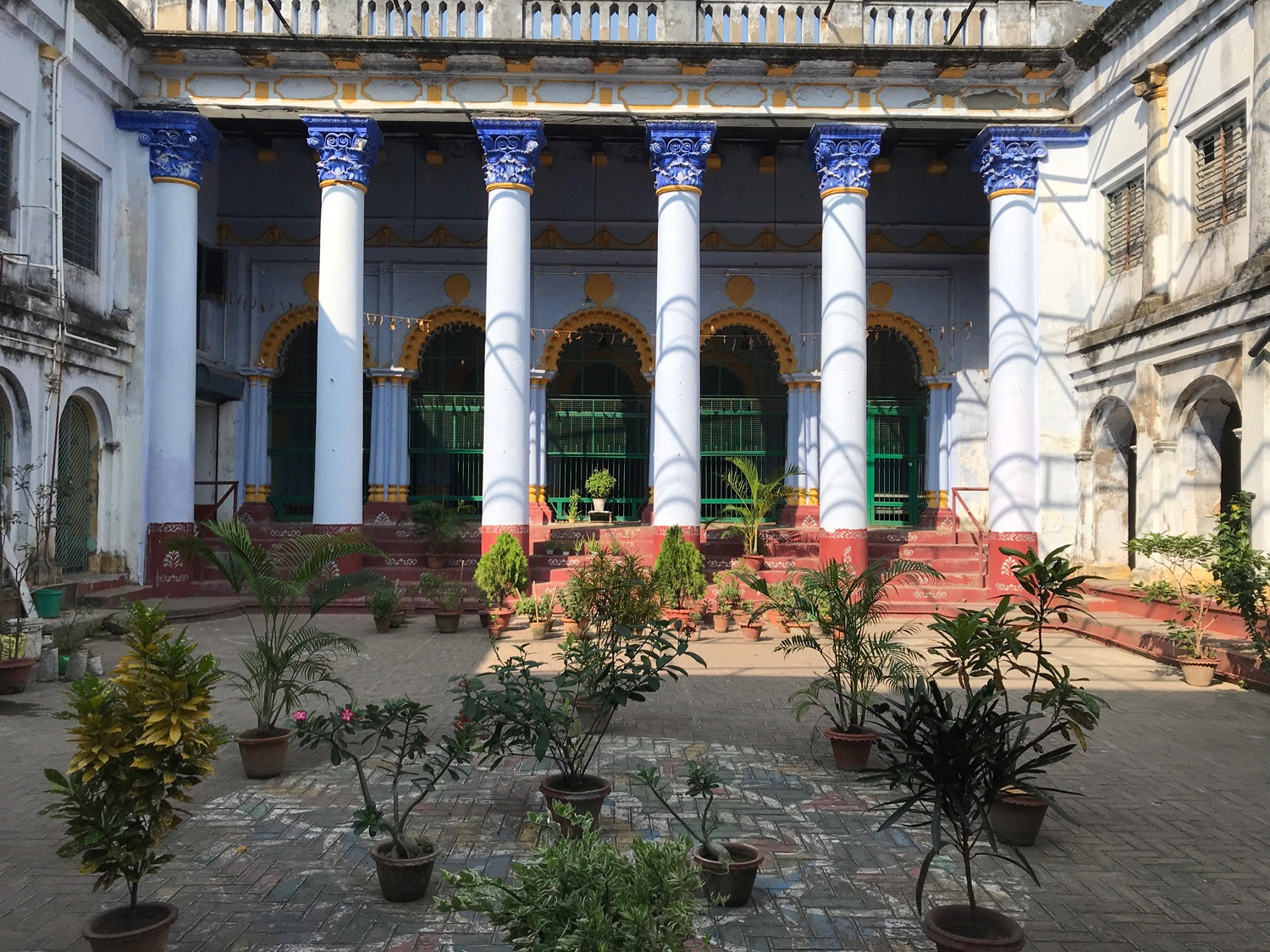 Dey Bari; another of Serampore’s wealthy merchant-homes
Dey Bari; another of Serampore’s wealthy merchant-homesAnd finally, to the Tavern for a drink and a meal
And so, to close out an exploration-filled day, we made for the busy Denmark Tavern for a drink and a meal.
Like other parts of Serampore, this building too has been restored with its own back-story. The tavern was originally opened as far back as 1786 as a riverfront café and lodge by a British innkeeper James Parr, and advertised in the Calcutta Gazette “…for gentleman passing up and down the river” with “breakfast, dinner, supper and lodging; also liquors sold by the single dozen and a good billiard table and coffee room with the newspapers”. Today it is run by Park Hotels.
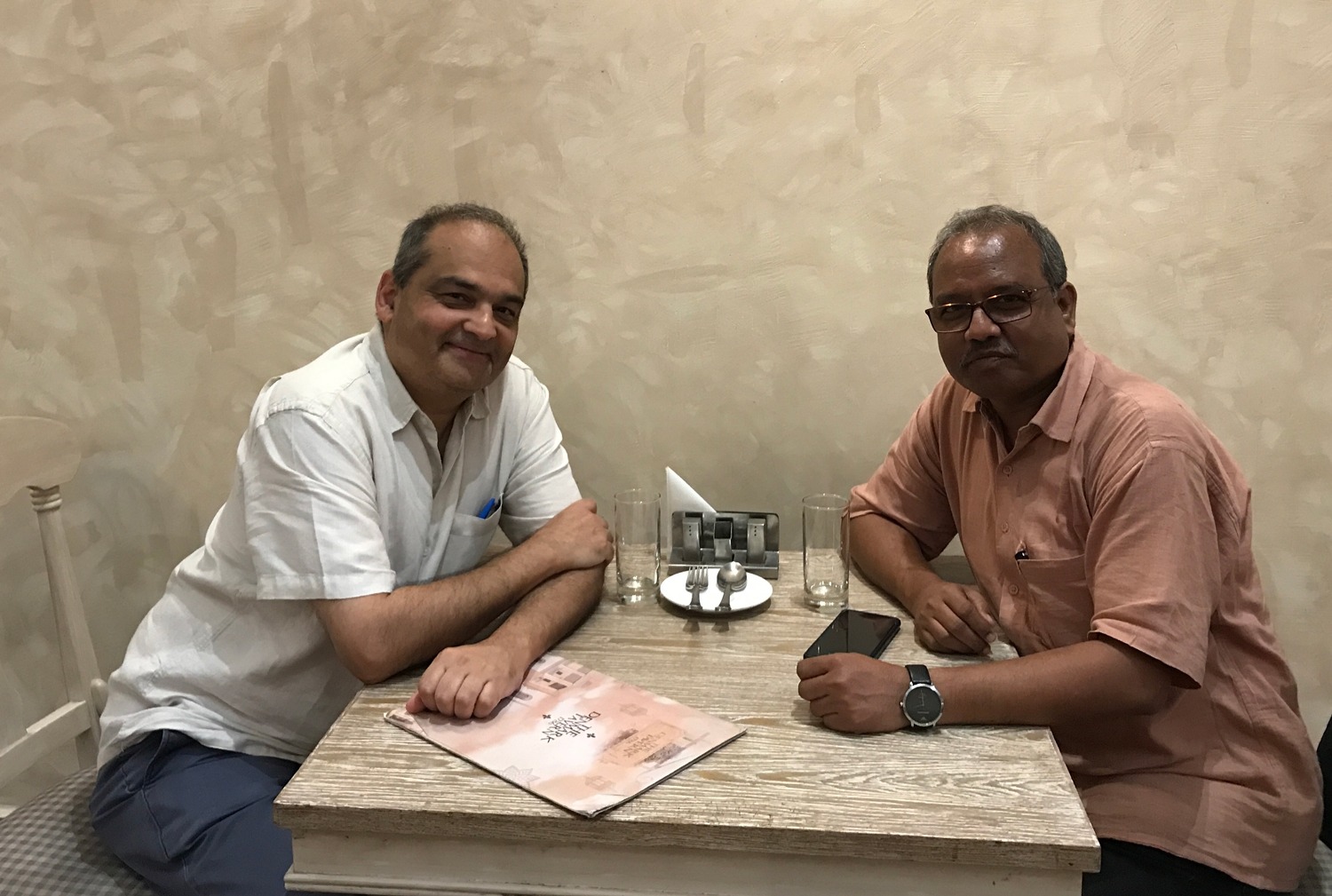 Winding down at Denmark Tavern with my guide for the day; Mohit Ranadip, the Serampore heritage expert
Winding down at Denmark Tavern with my guide for the day; Mohit Ranadip, the Serampore heritage expert
Over Danish-style sausages and Danish pastry, Mohit and I discussed the day as we took it all in. Clearly, thanks to the efforts of many, Serampore’s distinctive Danish-English-Bengali heritage has got a wonderful new lease of life. It is waiting for the travelers in us to explore and enjoy. Go, discover.
* “Journal and Letters of the Rev Henry Martin B.D. ”. Edited by the Rev S Wilberforce (pg 332)
How to get here:
-
- Serampore is about 30 kms from Kolkata.
- Cross the Vidyasagar Setu towards Howrah and drive along the NH 19.
- At Dankuni, turn right towards Burdwan and ffter passing the JSW Steel factory, turn right off the highway when you see signposts for Serampore.
- Drive a few miles through streets crowded with homes and shops till you come to the Serampore town center.
- The drive should take about 1.5 hours.
Information:
- If you’re driving from Kolkata, its best to park near the Denmark Tavern and use auto-rickshaws locally for the various attractions (the lanes within town are narrow and winding)
- You could cover all the attractions in about 5 hours
- Free entry to all monuments
- Toilet facilities are only at the Denmark Tavern
- No wheelchair access
Sources:
- “Journal and Letters of the Rev Henry Martin B.D””. Edited by the Rev S Wilberforce . Published by M.W. Dodd, New York
- “Serampore history and heritage”. By Smita Bajoria and Rajiv Soni
- www.bu.edu (BU school of Theology)

